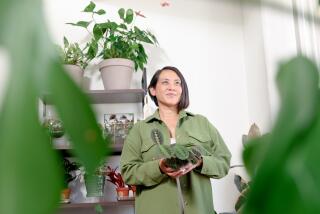Plant That Reacts to Touch Is Hard to Grow
- Share via
QUESTION: I recently saw a beautiful little plant at my local garden center that my 7-year-old son demanded that I buy for him. It has a most exciting feature: When you touch the leaves, they close right up! The nursery person told me it was called a sensitive plant and it was difficult to grow, but I bought one anyway. Now what?
ANSWER: You and your son enjoy it while it lasts! The sensitive plant (Mimosa pudica) is a wonderful curiosity that’s especially loved by kids of all ages. It closes its leaves tightly at the slightest touch, only to open them a few minutes later when it senses the danger has passed. (This reaction may be the plant’s defense against herbivores.) This plant can be difficult to cultivate outside a greenhouse, but it’s worth a try: Give the plant filtered eastern light, keep the soil moist and keep the humidity as high as possible.
Sago Palms Are Almost Indestructible
Q: Can a sago palm live indoors? If so, can you please provide me with some care tips?
A: Not only can a sago palm (Cycads revoluta) live indoors, these prehistoric plants are practically impossible to kill. Perhaps because most cycads can trace their origins back to the age of the dinosaurs, they have developed an ability to survive practically any travail.
For maximum results, keep your sago palm in eastern or filtered western light and water only when the soil dries out. (Unlike true palms, cycads prefer to be dry between watering.)
Shrimp Plant Goes Dormant in Winter
Q: I have a shrimp plant that bloomed beautifully all summer, but now the blooms are gone and it looks like the plant is dying! Help!
A: Not to worry. Your shrimp plant (Beloperone gutatta) is simply going dormant for the winter. It’s a good idea to prune the plant about halfway back now, water when the soil dries out and discontinue feeding. Resume your regular watering schedule in early March, keeping the soil uniformly moist, and at the same time resume feeding once every two weeks with a good liquid houseplant food.
If you grow the plant in a bright, sunny spot and spray frequently to keep the humidity high, B. gutatta should produce shrimp-colored flowers, hanging from the ends of the stems, all the way through next October or November.
Spanish Moss Lives and Grows on Air
Q: I’ve got a question about Spanish moss--you know, that silvery-gray stringy stuff that florists use to decorate the tops of potted plants? Somebody told me that it was actually a living plant! Is that true?
A: Absolutely. Spanish moss (Tillandsia usneiodes) is the ultimate air plant--those ephyphytic wonders that get all the nutrition they need right out of the air instead of the soil. This fascinating and extremely decorative plant is not a moss but a bromeliad. It loves the shade. Mist it daily and add a teaspoonful of plant food to the misting water once a month.
You can use Spanish moss for indoor decor--hang it from the branches of treelike plants (just as it grows in its natural habitats in places as diverse and far-ranging as Canada, Florida or semitropical South America). It’s also very pretty growing out of a pot--hiding the soil while at the same time cascading down over the sides. Since it is used so often as a decorative accent, Spanish moss is usually available (in bags) in a good nursery, garden center or flower shop.






